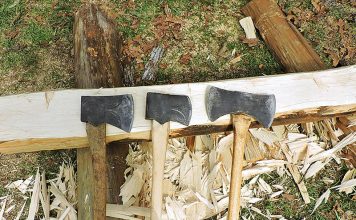 |
|
| Issue #94 • July/August, 2005 |
|
Most of my past articles described solar systems that included a battery or batteries to store the collected solar energy. There are many types of solar power systems with battery backup that can be connected to the utility grid. However, technically speaking, a “grid-tie” system refers to a solar power system that transfers all of the electrical power generated directly back into the local utility grid and does not have a battery bank.
Not needing a battery bank can greatly simplify system complexity and reduce installation costs, but by code the system is not allowed to produce any power when the utility grid is down, which means a grid-tie solar system is not suitable for use as an emergency backup power system. It will, however, significantly reduce your monthly utility costs, and since there are no batteries to maintain and periodically replace, there is almost no maintenance involved with a grid-tie solar system.
System components
|
A grid-tie solar photovoltaic system consists of individual solar modules wired together to create a solar array, one or more inverters to convert the solar DC power to AC grid quality power, and associated switchgear and wiring.
Although almost any size solar module can be used, most grid-tie solar inverters operate at much higher voltages than a typical 12 to 48-volt battery based solar power system, which allows more solar modules to be wired into each series “string.” Solar modules for grid-tie systems are usually chosen in the larger 100- to 300-watt per module size range, and usually include pre-wired weatherproof male and female plug connectors as shown in photo #2.
This means high voltage solar array wiring consists of just “plugging” the positive connector of one module into the negative connector of the next module until they are all connected together, with a final positive and negative connection made at the start and end of the array string. A word of caution is in order. Since most grid-tie inverters will allow 16 or more individual modules to be wired in each series string, you could easily be dealing with voltages over 340 volts DC, and this will generate a very large arc and very hazardous conditions if you do not use the proper components and wiring.
|
This grid-tie project required mounting thirty-two 165 watt solar modules on a raised seam metal barn roof. Fortunately, the solar industry now provides precut mounting systems for almost any solar module mounting arrangement, and we found a design that included clamping blocks that anchored the mounting rails directly to the raised seams of the metal barn roof.
Photo #3 shows how these adjustable high strength aluminum mounting rails and related stainless steel hardware were attached to this barn roof.
Photo #4 shows the array installation beginning with the attachment of the solar modules to the mounting rails. Since each module just “plugs” into the next, the array wiring is completed as each module is physically attached to the mounting rack.
Utility interconnection
|
Since you are using the local utility grid as your “battery,” not all electric utilities will look kindly to sending electric power back into their utility lines and turning electric meter backwards in the process. You will need to check with your local utility company before installing a grid-tie solar power system to make sure they allow this type of interconnection.
Most states that do require their electric utilities to offer net-metering have a simple, no cost application process. Some utilities will require changing out your existing electric meter to allow them to separately record your electric flows in both directions, while a few electric utilities are still down right hostile to anyone wanting to back-feed power to the grid. Older style mechanical dial electric meters will run backwards for any reverse electrical flow and subtract from the total monthly reading, while most new electronic meters are programmed to ignore any reverse flow. There are currently 35 states that allow utility interconnection or net-metering. Although the utilities that do allow interconnection have different rate structures and billing arrangements, most will allow a monthly carry-forward credit balance, which means those summer months when you generate more power than you use will offset purchased electrical power you used later during the winter months.
|
Ideally you would like to have any solar electric power sold at the same rate that you purchase electricity. This is called net-metering since you are just paying the difference between what you use and what you produce. However, some utilities only pay a very low rate for the solar power they purchase even though it is being supplied during their afternoon peak load period when their high demand generation costs are much higher.
Utilities operating in states that do allow net-metering usually require your system to include a manual disconnect switch located next to the electric meter so they can “lock-out” the solar power grid connection when they are doing any maintenance on the nearby power lines. Since utility linemen will always earth ground and disable any power lines before they start working, and will most likely not even know if you are located near their repair location, it is doubtful that this switch will ever be actually used. Utilities will also require that you provide documentation that your inverter meets UL 1741, IEEE 929, and NEC Art. 690 code requirements, which ensure the inverter will automatically disconnect from the utility line anytime the grid is not energized.
Photo #6 shows our completed 5,280 watt installation on the south-facing roof of the barn. This system will generate almost all of the power needs of this hay barn, which includes a repair shop, carpentry shop, and small office.
|
Although the simplicity of a grid-tie system makes it easy for a do-it-yourselfer to install, if you are not an experienced electrician, I strongly recommend hiring a professional due to the very high voltages involved with these systems. A list of professionally trained and certified solar photovoltaic installation professionals located in each state can be found on the Internet under the North American Board of Certified Energy Practitioners, (NABCEP).
On a final note, although solar power system costs for the same size system will be competitive from state to state, different utility rates, local tax credits, and state rebate or buy-down programs offered in some states and not others can make this either a really good investment or a very poor one. Be sure to find out what utility rates and incentive programs are available in your area before making your final purchasing decision.
[weaver_widget_area id=’articles_about_yago’ class=’text3′]




















